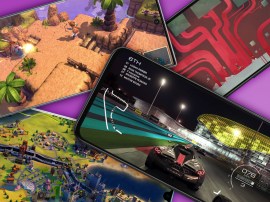The amazing ways new tech shapes storytelling
Technology not only changes the fabric of how stories get told, but also the actual stories themselves, says Stephen Graves

From the moment some singer-poet livened up his verse performances with a musical instrument, technology has changed entertainment. The printing press, theatrical lighting, the cinema, radio, cinematic sound – they’ve all either impacted on existing storytelling forms, or created whole new ones.
In recent years, the arrival of digital formats and non-linear editing changed TV. Existing TV formats like drama benefited from the same level of technical polish as films; and at the same time, the ability to shoot and edit large amounts of footage quickly and cheaply created a whole new form of storytelling – reality TV.
Rise of the box set
The emergence of TV streaming services like LoveFilm and iPlayer has given rise to box-set binges where viewers plough through entire TV series in a weekend. That’s already starting to change the structure of TV drama: where broadcast TV has always been shaped around fixed episode lengths and advertising breaks, online streaming has no such restrictions.
Writers don’t have to have a dramatic cliffhanger before the ad break any more – instead the broadcaster can vary the length of episodes to suit the needs of the story. That means in future, we could have a one-hour episode of Battlestar Galactica followed by a 15-minute one; the producer of House of Cards has already talked about releasing the series in a single 8-hour block, for viewers to dip into and out of as they choose.
READ MORE: Video games are good for you
Phone home
Streaming media’s one thing – but the biggest tech leap in years is, of course, your smartphone. Texting during films may infuriate but whipping your phone out in the cinema may become an integral part of the story: the 2013 film App used a second-screen app to display extra layers of narrative, synced to the film’s soundtrack. There are books that use second-screen apps: last year’s Night Film lets you scan tags in the physical book to unlock extra content, including mocked-up websites and trailers.
It’s in the blood
The smartphone has far more potential than that, though. A complex sensor array that tracks your orientation, your location and – nowadays – your biometrics – it’s opening the door to new ways of telling stories. At a basic level, there are titles like Device 6, an ebook/game which requires you to tilt and turn your iPhone to navigate the narrative.
Other games are using location to influence their narrative like fitness tracker Zombies, Run! and Niantic Labs’ Ingress. Although the storytelling in these titles is fairly basic, it’s easy to imagine a future of location-based storytelling. Imagine, for example, if The Da Vinci Code required you actually to walk around Paris, uncovering clues (though hopefully with better writing).
Something new
We’re also starting to see the first interactive stories that use your own body to influence the narrative through your biometrics, like the short film Many Worlds, which changes its ending based on biometric tracking from audience members. With sensors like Kinect becoming more prevalent, there could be a wave of interactive stories that don’t need your conscious input.
READ MORE NEW PERSPECTIVES: promoted
3D printing is going to ruin everything, if you’re a manufacturer
You can’t all be a Jedi Knight
The arrival of interactive storytelling could influence narrative in a more profound way, though. It’s been around for a while, of course, in the form of the video game – and several recent games have used interactivity as a key component in the story, like Braid, Bioshock and The Stanley Parable. In recent years, we’ve seen the emergence of the massively multiplayer game – and its impact on the type of stories we tell is already being felt.
Back in 1977, George Lucas used Joseph Campbell’s Hero With A Thousand Faces as the basis for Star Wars. Hollywood followed suit and the result is that for the last 30 years, mainstream cinema (and much of our pop culture) has been based on Campbell’s ‘monomyth’, the Hero’s Journey. Briefly: a Chosen One is called into action, a wise mentor guides them, they venture into the underworld, return with a trophy and overcome the force that’s standing in their way. It’s the Odyssey, Harry Potter and The Matrix.
Video games have, unsurprisingly, flattered, putting players in the role of the uniquely powerful Chosen One.
But then massively multiplayer games came along: suddenly, you weren’t the hero. You were being pwned by some 11-year-old in middle America, who’d frag you and insult your mum while doing it. Suddenly, gamers across the world had to come to terms with the notion that they couldn’t all be Jedi Knights. Some people had to be content to make the Jedi Knights’ shoes.
READ MORE: The smart screen of the future actually touches back
This is where we’re going
The result? We’re seeing a wave of games in which competition gives way to collaboration. From Destiny‘s cooperative gameplay to GTA Online crews getting together to create wild stunts, to Disney Infinity’s playgrounds, games are becoming spaces for collective endeavour. In the long term, that could have a profound impact on the type of stories we tell: not myths about heroes conquering all because of destiny, but stories about people coming together to overcome the challenges.
It’s possible, then, that the arrival of the cooperative video game could do what even Darth Vader and Voldemort couldn’t – do away with the Chosen One.
The writer…
Stephen Graves is deputy online editor of Stuff.tv



